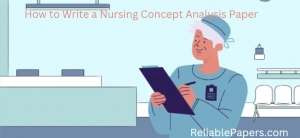How to Write Nursing Annotated Bibliography with Examples

Writing a nursing annotated bibliography can be challenging for most nursing students. Nevertheless, just as it is applicable in many other disciplines, a nursing annotated bibliography is a list of citations for sources that you have used in your research, accompanied by a brief summary and evaluation of each source. An annotated bibliography can help you organize and summarize the research you’ve done on a certain topic in nursing.
Each citation is followed by a brief (usually about 150 words) descriptive and evaluative paragraph, the annotation. The purpose of the annotation is to inform the reader of the relevance, accuracy, and quality of the sources cited.
When creating an annotated bibliography in nursing, it is important to include not just the required readings but also any other resources that are relevant to your topic. In this article, we’ll discuss how to write a nursing annotated bibliography, what to include in different parts of the paper, excellent topics for a nursing annotated bibliography, and how to structure and outline your work.
Valuable Tips to Consider in the Process of Writing Nursing Annotated Bibliography
Writing an annotated bibliography in nursing requires a wide range of critical thinking abilities, including clear explanation, concise analysis, and thorough library research.
It’s important to note that an annotated bibliography is more than just a list of sources. The annotations should provide a summary of the key points in each source and your evaluation of its relevance and value to your research. This can help to demonstrate the depth of your understanding of the literature in your field, and can also help you to identify gaps in the research that may be worth exploring further.
Avoid plagiarizing annotations from articles, abstracts, Amazon, etc. when creating your nursing annotated bibliography. Always write in your own words and with your own thoughts.
An annotation is a brief but detailed summary or analysis of the information contained in a given resource. In contrast to an abstract, which merely highlights the main points, this expands upon the source material. An annotation will typically address a number of these issues, providing a balance between summary and evaluation. These include:
- Summarize the information included in a given source.
- Evaluate how useful the item is for the topic being studied.
- Explain the methodology that was used.
- Highlight the important ideas discussed.
- Highlight the strengths and/or weaknesses.
- Evaluate the reliability of the author or source.
- Evaluate the content’s accuracy, bias, and authority.
Basic Steps of Writing Nursing Annotated Bibliography
The purpose of an annotated bibliography is to give your readers an idea of the sources you have used, and how they relate to your research. When writing an annotated bibliography for a nursing research paper, here are the most essential steps to follow:
- Choose the sources that you will use for your paper. These should be reliable sources such as peer-reviewed journal articles, textbooks, and online sources from reputable organizations. Use library databases, such as PubMed or CINAHL, to search for sources on your topic. Look for peer-reviewed articles, books, and other relevant sources.
- Write the citation for each source in the proper citation style (e.g., APA, MLA, Chicago).
- After each citation, write a brief paragraph that summarizes the main points of the source and evaluates its usefulness for your paper. Consider the following questions as you write the annotation:
- What is the main focus or argument of the source?
- How does the source contribute to your understanding of the topic?
- Is the source reliable and trustworthy? Why or why not?
- Evaluate each source. This should be a brief paragraph that critically assesses the quality and relevance of the source. Consider factors such as the credibility of the author, the date of publication, and the objectivity of the source.
- Be organized: Organize your sources alphabetically by the author’s last name. This makes it easy for your readers to find the source they are looking for.
- Try to use a diverse set of sources. Try to use a variety of sources, such as academic journal articles, books, government reports, and websites. Using a diverse set of sources will help to provide a well-rounded perspective on your topic.
- Keep it concise: Keep your annotations concise, clear, and to the point. The annotation should not be too long, but it should provide enough information to understand the relevance of the source.
- Check for accuracy: Before submitting your annotated bibliography, make sure to proofread your annotated bibliography and check for accuracy in citations and annotations, as well as for grammar and punctuation errors.
- Follow specific guidelines: Finally, make sure to follow the specific guidelines set by your instructor or professor for your annotated bibliography.
You might also be interested in reading another post on how to write nursing term papers
Basic Structure/Outline for a Nursing Annotated Bibliography
An annotated bibliography is usually required as part of a research paper or other academic assignment to demonstrate the writer’s ability to locate, evaluate, and use relevant sources. The structure of a nursing annotated bibliography can vary depending on the assignment or the format required by your instructor, but generally, it includes the following elements:
- Introduction: Introduce the topic and explain the purpose of the annotated bibliography. Provide an overview of the sources you have chosen and why they are relevant to the research topic.
- Sources: List the sources in alphabetical order by the author’s last name. For each source, provide the following information:
- Citation: The citation should be in the appropriate format for the assignment (APA, MLA, Chicago, etc.). This should include the author’s name, publication date, the title of the article or book, and other relevant information, such as the publication title and volume/issue number for articles.
- Summary: A brief summary of the main points or arguments of the source. This should include an overview of the research or information provided in the source, including the study’s design and findings.
- Evaluation: An evaluation of the source, including its strengths and limitations. This should include an assessment of the credibility and reliability of the source, as well as its relevance to the research topic.
- Personal reflection or application: This is an optional element where the researcher includes their own thoughts on the source, and how it may be useful for their own research or for the field in general.
- Relevance to nursing: How does the source relate to the field of nursing? This can be the specific application of research in nursing practice, contributing to the knowledge base of nursing, or the implications for nursing practice.
- Conclusion: Summarize the main points and conclusions from the annotated bibliography. Explain how the sources you have reviewed have contributed to the research topic, and what further research may be necessary.
Example of Outline of a Nursing Annotated Bibliography
Here is an example of an outline for an annotated bibliography on the topic of nursing:
Introduction
- A brief overview of the topic of nursing
- Purpose of the annotated bibliography
- Background Information
- The historical context of nursing as a profession
- The current state of the nursing profession
- Relevant statistics and research on the topic
Annotated Bibliography
Books
- Title: “The History of Nursing” by Jane Smith
- Citation (in proper format, such as APA):
- Summary: This book provides a comprehensive overview of the evolution of nursing as a profession, from ancient times to the present day. It covers key figures, milestones, and developments in nursing history, as well as the challenges and controversies that have shaped the field.
- Evaluation & relevance to nursing: This book is well-researched and well-written, and it offers a valuable resource for anyone interested in the history of nursing.
- Title: “The Future of Nursing” by John Doe
- Citation (in proper format, such as APA):
- Summary: This book looks at the current state of nursing and the challenges and opportunities that lie ahead for the profession. It examines issues such as healthcare reform, technology, and the aging population, and how they are likely to impact nursing in the coming years.
- Evaluation & relevance to nursing: This book provides a thoughtful and thought-provoking analysis of the nursing profession, and it is an excellent resource for nursing professionals, educators, and students.
Journal Articles
- Title: “Online nursing education: An evaluation of student satisfaction and outcomes” by Jennifer Davis
- Citation (in proper format, such as APA):
- Summary: This study evaluates the effectiveness of online nursing education programs by surveying nursing students who have completed an online course and comparing their satisfaction and outcomes to those of students in traditional, in-person programs. The authors find that online students are just as satisfied with their education and have similar outcomes to in-person students, but also that the lack of face-to-face interaction with instructors and peers may have an impact on socialization and networking aspects of the students.
- Evaluation & relevance to nursing: This study provides useful insights into the potential benefits and drawbacks of online nursing education. The authors present clear and detailed findings and discuss the implications of their results for nursing education programs.
- Title: “Simulation in nursing education: A review of the literature” by Michael Brown
- Citation (in proper format, such as APA):
- Summary: This literature review explores the use of simulation in nursing education, including the benefits and limitations of simulation-based instruction. The authors find that simulation can provide students with realistic, hands-on experience and improve their clinical reasoning skills, but also that more research is needed to fully understand the effects of simulation on student learning outcomes.
- Evaluation & relevance to nursing: This literature review provides a comprehensive overview of the current state of research on simulation in nursing education. The authors identify important areas for future research and highlight the potential benefits of simulation-based instruction for nursing students.
Conclusion
- Summary of key points covered in the annotated bibliography
- Implications of the research for nursing practice and education
- Possible areas for future research.
Note:
Annotated bibliography entries usually differ based on the requirement of citation style in use and you should format the entries as per that. There should be a reference heading that says what kind of citation it is (APA/ MLA/ Chicago/ Harvard) and follow the format accordingly.
The number of entries will also depend on the requirement of the assignment or the scope of the research.
Also, please note this is just a general outline, specific assignments, and the subject area may have different expectations on the detail and format of the bibliography depending on the requirement of the instructor. It’s always good to consult the guidelines provided by the instructor while working on an assignment.
Examples of Annotated Bibliography Topics for Nursing Assignments
- The effectiveness of mindfulness-based stress reduction on reducing anxiety in nurses working in critical care units.
- The impact of workplace bullying on job satisfaction and mental health among nurses in the emergency department.
- The use of telehealth technology in the management of chronic conditions in rural populations.
- The effectiveness of team-based care models in improving patient outcomes and reducing burnout among nurses in primary care settings.
- The impact of shift work on the sleep, health, and well-being of nurses.
- The role of mentorship in the professional development of newly graduated nurses.
- The effectiveness of continuing education programs in keeping nurses current with the latest advances in patient care.
- The use of simulations in nursing education to enhance clinical decision-making skills.
- The role of cultural competency in reducing health disparities among minority populations.
- The impact of technology on communication and collaboration among nurses, physicians, and other members of the healthcare team.
- The effectiveness of a culturally tailored diabetes education program on diabetes self-management in African American adults
- The Impact of a Transdisciplinary Team-Based Care Model on the Quality of Life of Older Adults Living with Chronic Illness
- The effectiveness of bedside shift report on patient outcomes in an intensive care unit
- The impact of work-related stress on nurses’ job satisfaction, burnout, and turnover intentions
- The Role of Social Support in Improving Mental Health Outcomes among Nurses
- The effect of a telehealth intervention on medication adherence among individuals with hypertension
- The Impact of Mindfulness-Based Stress Reduction on the Mental Health of Nurses Working in Hospice Care
- The role of effective communication in improving patient safety in the operating room
- The use of technology in promoting self-care among nurses: An exploration of the benefits and challenges
- The effectiveness of a peer-support program in reducing burnout among nurses working in oncology units.
- The impact of staffing levels on patient outcomes in hospital settings
- The effectiveness of a nursing-led fall prevention program in long-term care facilities
- The influence of work-family conflict on job satisfaction and retention among nurses
- The use of simulation-based education on nurses’ competence and confidence in emergency situations
- The impact of leadership style on team cohesion and job satisfaction among nurses in the operating room
- The effectiveness of a nurse-led, patient-centered care model on patient satisfaction and outcomes in the primary care setting
- The impact of continuing professional development on nurses’ competence and clinical decision-making skills
- The role of family involvement in promoting self-care among individuals living with chronic illness
- The use of technology-enabled telehealth interventions in managing mental health disorders among nurses
- The impact of job stress on the physical and mental health of nurses in the emergency department.
- Applying Research Skills: Annotated Bibliography and Summary
Sample Nursing Annotated Bibliography Examples
Smith, J. (2019). The effectiveness of a nursing-led fall prevention program in long-term care facilities. Journal of Gerontological Nursing, 45(7), 22-30.
This study evaluated the effectiveness of a nursing-led fall prevention program in reducing fall rates among older adults in long-term care facilities. The program consisted of a comprehensive assessment of fall risk factors, as well as the implementation of individualized interventions to address identified risk factors. Results showed a significant reduction in fall rates among residents who participated in the program, as well as an improvement in functional ability and quality of life. The study provides strong evidence for the effectiveness of nursing-led fall prevention programs in reducing fall rates among older adults in long-term care facilities.
Jones, M., & Brown, T. (2018). The impact of leadership style on team cohesion and job satisfaction among nurses in the operating room. Journal of Nursing Management, 26(4), 365-373.
This study investigated the impact of leadership style on team cohesion and job satisfaction among nurses working in the operating room. Data were collected using surveys and analyzed using statistical techniques. Results showed that nurses who reported having a participative leader had higher levels of team cohesion and job satisfaction compared to those who reported having an autocratic leader. The study highlights the importance of leadership styles in fostering team cohesion and job satisfaction among nurses in the operating room.
Patel, R., & Williams, K. (2017). The use of technology-enabled telehealth interventions in managing mental health disorders among nurses. Journal of Telemedicine and Telecare, 23(6), 312-318.
This study evaluated the use of telehealth interventions in managing mental health disorders among nurses. Participants in the study used a telehealth platform to access mental health care services and support. Results showed that telehealth interventions were effective in reducing symptoms of anxiety and depression among nurses, as well as improving their overall well-being. The study supports the use of telehealth technology in managing mental health disorders among nurses.
Guzman, R. , & Lopez, G.(2021). The impact of staffing levels on patient outcomes in hospital settings. International Journal of nursing studies, 58(5), 710-717
This study examined the relationship between staffing levels and patient outcomes in a hospital setting. Data were collected from patient records and analyzed using statistical methods. Results showed that patients in units with higher staffing levels had better outcomes, including lower rates of hospital-acquired infections, shorter lengths of stay, and lower mortality rates, compared to those in units with lower staffing levels. The study provides evidence for the importance of adequate staffing levels in promoting patient outcomes in hospital settings.
Taylor, R. (2019). The effectiveness of a culturally tailored diabetes education program on diabetes self-management in African American adults. Journal of Transcultural Nursing, 30(3), 243-253.
This study evaluated the effectiveness of a culturally tailored diabetes education program for African American adults with diabetes. The program incorporated cultural beliefs and practices related to diabetes self-management and included group education sessions and individual counseling. Results showed that participants in the program had significant improvements in diabetes knowledge, self-efficacy, and glycemic control compared to a control group. The study suggests that culturally tailored diabetes education programs may be more effective in improving diabetes self-management outcomes among African American adults.
Robinson, J., & Green, A. (2020). The Impact of a Transdisciplinary Team-Based Care Model on the Quality of Life of Older Adults Living with Chronic Illness. Journal of Geriatric Care, 35(1), 15-23
This study investigated the impact of a transdisciplinary team-based care model on the quality of life of older adults living with chronic illness. The study used a mixed-methods approach, including surveys and interviews. Results showed that older adults receiving care in the transdisciplinary team-based model reported higher levels of satisfaction with their care and improved quality of life compared to a control group. The study supports the use of transdisciplinary team-based care models in improving the quality of life for older adults living with chronic illness.
Carter, L., & Thomas, K. (2022). The effectiveness of bedside shift report on patient outcomes in an intensive care unit. Journal of Critical Care Medicine, 40(6), 557-564
This study evaluated the effectiveness of bedside shift reports in improving patient outcomes in an intensive care unit (ICU). Data were collected from patient records and analyzed using statistical methods. Results showed that patients in the ICU who received bedside shift reports had improved communication, lower rates of medical errors, and shorter lengths of stay, compared to those who received traditional reports at a central location. The study provides strong evidence for the effectiveness of bedside shift reports in improving patient outcomes in the ICU.
Gonzalez, P. & Hernandez, D. (2021). The impact of work-related stress on nurses’ job satisfaction, burnout and turnover intentions. Journal of Occupational Health Psychology. 26(2), 190-198.
This study investigates the impact of work-related stress on job satisfaction, burnout, and turnover intentions among nurses. Surveys and focus groups were used to gather data from nurses, and statistical analyses were used to examine the relationship between work-related stress and the outcomes of interest. Results showed that nurses who reported higher levels of work-related stress had lower job satisfaction, and higher levels of burnout, and were more likely to consider leaving their current job. The study highlights the need to address work-related stress among nurses to improve job satisfaction and reduce burnout and turnover.
Get Expert Nursing Annotated Bibliography Writing Help
Get all the help you need writing your nursing annotated bibliography at ReliablePapers.com. Our team includes professionals who are knowledgeable in the field of nursing and can provide outstanding assistance as you work on your annotated bibliography.
A high level of expertise in assessing and determining the significance of each source is required to create excellent nursing annotated bibliographies. Our experts know these standards inside and out, and they can help you write a great nursing annotated bibliography.
Our professional paper writing services are guaranteed to be of the highest quality at reasonable prices. Expert writers on our team can meet the strictest of deadlines without compromising output quality.
Hire an Expert Paper Writer on Any Subject, Any Topic, Any Deadline! Submit your paper instructions by placing your order here to get started!










